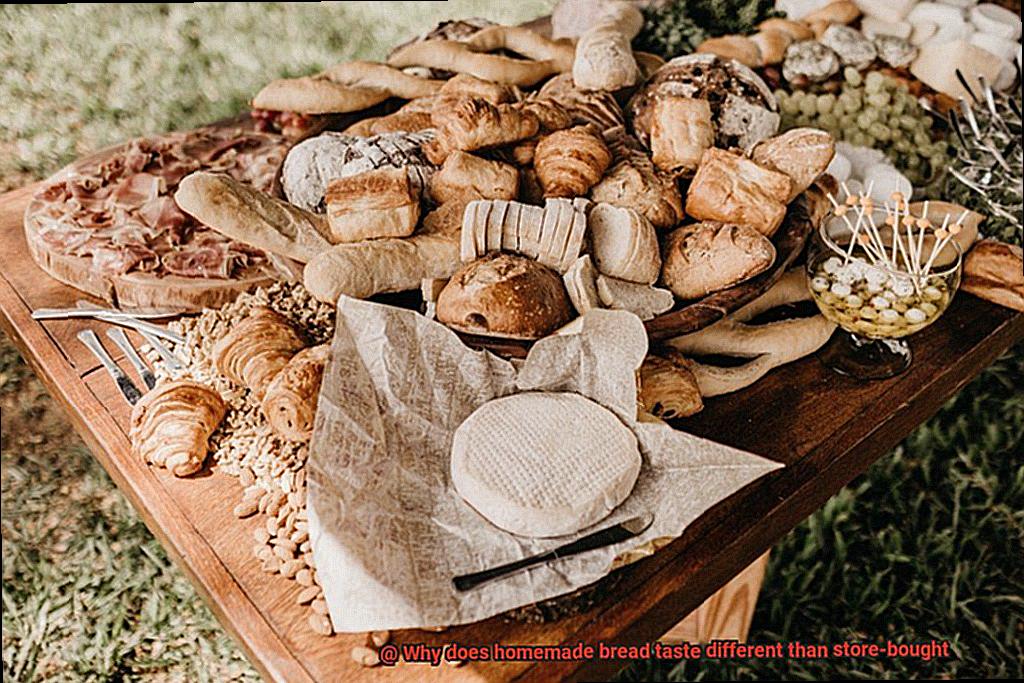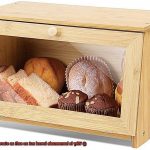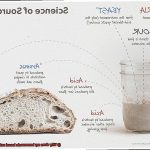Ah, the smell of freshly baked bread. Is there anything better? But have you ever wondered why homemade bread tastes so different from store-bought bread? Well, let’s dive in and explore the reasons behind this delicious mystery.
Firstly, store-bought bread often contains artificial preservatives, flavorings, and sweeteners that alter the taste and texture of the bread. These sneaky additives may extend the shelf life of bread but can leave behind an unpleasant aftertaste that feels less natural than homemade bread.
Secondly, when making bread at home, bakers knead and shape the dough by hand. This hands-on approach allows for a more personalized experience where the consistency and feel of the dough are adjusted to perfection. In contrast, store-bought bread is mass-produced by bulky machines that lack a personal touch.
Moreover, fermentation time and temperature play a crucial role in determining the flavor of bread. Homemade bread’s slower fermentation process allows for more lactobacilli and yeast to develop, creating complex and wholesome flavors. Store-bought bread has a faster fermentation process that hinders the development of these complex tastes.
Last but not least, homemade bread is made with love, care, and attention to detail. Each ingredient is carefully measured, mixed, and shaped to create a unique experience that cannot be replicated in a mass-produced loaf.
In conclusion, homemade bread is simply superior when it comes to taste and texture. The natural ingredients combined with slow fermentation processes create an unforgettable experience that will make your taste buds dance with joy. So next time you crave some fresh bread – grab your apron and get baking.
Contents
Comparison of Ingredients Used in Homemade and Store-Bought Breads
Understanding the comparison of ingredients used in homemade versus store-bought bread is essential.
Let’s start with the number of ingredients. Homemade bread is often made with simple, natural ingredients such as flour, water, yeast, and salt. In contrast, store-bought bread frequently contains additives and preservatives to improve its texture and extend its shelf life. These additives can adversely affect the flavor and quality of the bread.
The type of flour used is another significant difference between homemade and store-bought bread. Store-bought bread often uses bleached and refined flour that has been stripped of many nutrients. Homemade bread may use unbleached or whole wheat flour, which provides more fiber and nutrients and creates a nuttier flavor profile.
Fermentation is another key difference in the ingredients used in homemade versus store-bought bread. Homemade bread is often made with a slower fermentation process than store-bought bread. The longer fermentation process allows for more flavor development in the dough, resulting in a richer, more complex taste.
Baking temperature and time are also critical factors when comparing homemade and store-bought bread. Homemade bread is often baked at a higher temperature for a shorter period, resulting in a crispy crust and soft interior. Store-bought bread is usually baked at a lower temperature for a more extended period to ensure even baking throughout the loaf.
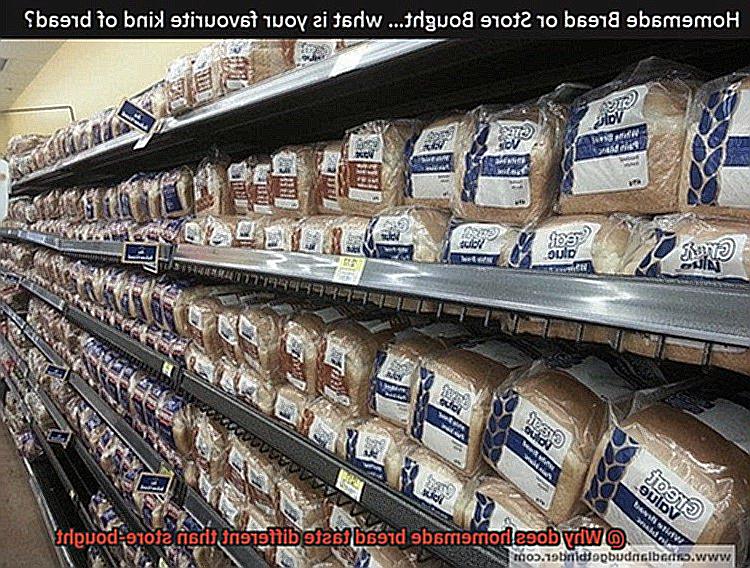
The Difference between Homemade and Store-Bought Fermentation Processes
The process of fermentation is a crucial step in bread making that affects the final flavor, texture, and overall quality of the bread.
When it comes to store-bought bread, the fermentation process is often rushed. Commercial producers use dough conditioners and other additives to speed up the process, which can compromise its flavor and texture. These additives also increase the shelf life of the bread, making it a more convenient option for consumers.
Conversely, homemade bread makers often use a slower and more traditional fermentation process. This involves allowing the yeast to ferment the dough over an extended period, resulting in a more complex flavor and texture. Home bakers have more control over this process, giving them the opportunity to experiment with different flavors and textures.
Let’s delve deeper into the sub-topics that help us understand the differences between homemade and store-bought fermentation processes:
Time:
Homemade bread makers take their time during the fermentation process, allowing the dough to rise naturally. In contrast, commercial producers prioritize speed and efficiency over flavor, leading to shorter fermentation times.
Additives:
Commercial bread producers use dough conditioners, preservatives, and other additives to ensure consistency and extend shelf life. In contrast, homemade bakers stick to natural ingredients only.
Control:
Home bakers have more control over the fermentation process than commercial producers. They can adjust variables such as temperature, humidity, and proofing time to achieve their desired results.
The difference in fermentation processes between homemade and store-bought bread is significant because it contributes to their distinct flavors and textures. By prioritizing speed and consistency over flavor, commercial producers compromise on taste. In contrast, home bakers take their time to achieve a unique flavor profile using natural ingredients only.
Baking Techniques for Homemade and Store-Bought Breads
Bread is a staple food that has been enjoyed by people around the world for thousands of years. From sliced and packaged loaves to artisanal sourdough, there are many different types of bread available for purchase. However, there is something special about homemade bread that sets it apart from store-bought bread. In this post, we will delve into the various techniques used in baking homemade and store-bought bread and explore how they impact their taste and overall quality.
When it comes to homemade bread, the process involves using simple ingredients such as flour, water, yeast, and salt. The dough is mixed by hand or with a stand mixer, allowed to rise, shaped and finally baked in an oven. This hands-on approach offers greater control over the quality of the ingredients and the baking process. As a result, homemade bread tends to have a fresher taste and a more desirable texture compared to store-bought bread.
In contrast, store-bought bread often contains preservatives and additives to extend its shelf life. The baking process used in commercial bread production is usually done on a larger scale and involves the use of industrial equipment. This can result in a less personalized approach to baking, which may lead to lower-quality ingredients and less attention to detail. Additionally, the use of preservatives can significantly alter the taste and texture of the bread.
If you’re looking to bake your own bread at home, there are several techniques you can employ to ensure it turns out just right. Firstly, using high-quality ingredients such as fresh flour and yeast is crucial. Secondly, it’s essential to pay attention to the temperature of your dough as it rises since it can affect how well your bread rises. Finally, when baking your bread, preheating your oven properly and allowing your bread to bake for the full recommended time ensures that it’s fully cooked.
Taste Differences between Homemade and Store-Bought Breads
Bread is a staple food that has been loved for centuries, and the debate of homemade versus store-bought bread is one that continues to rage on. As an expert in the taste differences between homemade and store-bought breads, I can tell you that there are several factors that contribute to these differences.
One of the most significant differences between homemade and store-bought bread is the quality of ingredients used. Homemade bread is made with high-quality ingredients, while store-bought bread often contains additives and preservatives that can affect the taste. This means that homemade bread has a richer, more complex flavor that cannot be replicated by mass-produced products.
Another factor that can affect the taste of homemade bread is the fermentation process. Homemade bread dough is often allowed to ferment for a longer period of time than store-bought bread, which allows for the natural sugars in the flour to break down. This creates a deeper and more complex flavor that is not found in store-bought bread.
But it’s not just about the ingredients and fermentation process – baking techniques also play a crucial role in the taste of homemade bread. Homemade bread is often baked at a higher temperature than store-bought bread, resulting in a crispy crust and a chewy texture that enhances the overall flavor of the bread.
In addition to these factors, there are other subtle differences that set homemade bread apart from its store-bought counterpart. For example, homemade bread may have slight variations in texture and flavor due to variations in temperature or humidity during the baking process. These subtle differences contribute to the unique and delicious flavor experience that homemade bread offers.
Nutritional Differences between Homemade and Store-Bought Breads
As a self-proclaimed bread connoisseur, I am often asked about the nutritional disparities between homemade and store-bought breads. It’s a valid question, as we all want to know what we are putting into our bodies. So, let’s take a closer look at the nutritional differences between these two types of bread.
Firstly, one of the most significant differences between homemade and store-bought breads is the use of preservatives. Many commercially produced breads contain additives such as high fructose corn syrup, dough conditioners, and artificial flavors to extend their shelf life. These ingredients can harm both the taste and nutritional value of the bread. In contrast, homemade bread typically contains fewer ingredients and no preservatives, making it fresher and healthier than store-bought bread.
Secondly, the flour used in bread-making plays a crucial role in its nutritional value. Most store-bought breads use refined flour, which has been stripped of its nutrients during processing. Homemade bread can be made with a variety of flours such as whole wheat, spelt, or rye flour. These flours contain more fiber and nutrients than refined flour, making homemade bread a more nutritious option.
Moreover, homemade bread is more likely to contain whole grains and natural sweeteners like honey or maple syrup. These provide more nutrients than processed sugars found in many store-bought breads. Plus, by making your own bread at home, you can adjust the amount of sugar you add to suit your dietary needs or preferences.
Finally, homemade bread offers an unrivaled level of customization to suit individual dietary restrictions. Those who are gluten-free can use alternative flours like almond or coconut flour to make their own bread at home. This allows for a more extensive range of options for those with dietary restrictions.
Cost Comparison of Homemade and Store-Bought Breads
Let’s break it down. When making homemade bread, you’ll need to consider the cost of ingredients, equipment, and time. Flour, water, yeast, and salt are the main components needed for basic bread. The cost of these ingredients will vary depending on where you live and where you purchase them. However, buying in bulk or choosing cheaper brands can save you money in the long run.
In addition to ingredient costs, equipment costs may be necessary for making homemade bread, such as a stand mixer or bread machine. While these expenses can seem daunting at first, they are one-time investments that will pay off in the long run as you can continue to make loaves of bread without any additional purchases.
On the other hand, store-bought bread is typically more expensive due to added costs associated with packaging and marketing. Moreover, it often contains preservatives to extend its shelf life, which can also add to its overall cost. By making your own bread at home, you can avoid these added expenses and have complete control over the quality of the ingredients used.
To sum it up, here’s a quick breakdown of the cost comparison between homemade and store-bought breads:
Homemade Bread Costs:
- Ingredients (flour, water, yeast, salt)
- Equipment (stand mixer or bread machine)
- Time
Store-Bought Bread Costs:
- The cost of the loaf itself
- Added costs associated with packaging and marketing
- Preservatives used to extend shelf life
Pros and Cons of Making Homemade Bread
Making homemade bread may be the perfect activity for you. However, before diving into the world of bread-making, it’s important to consider both the pros and cons.
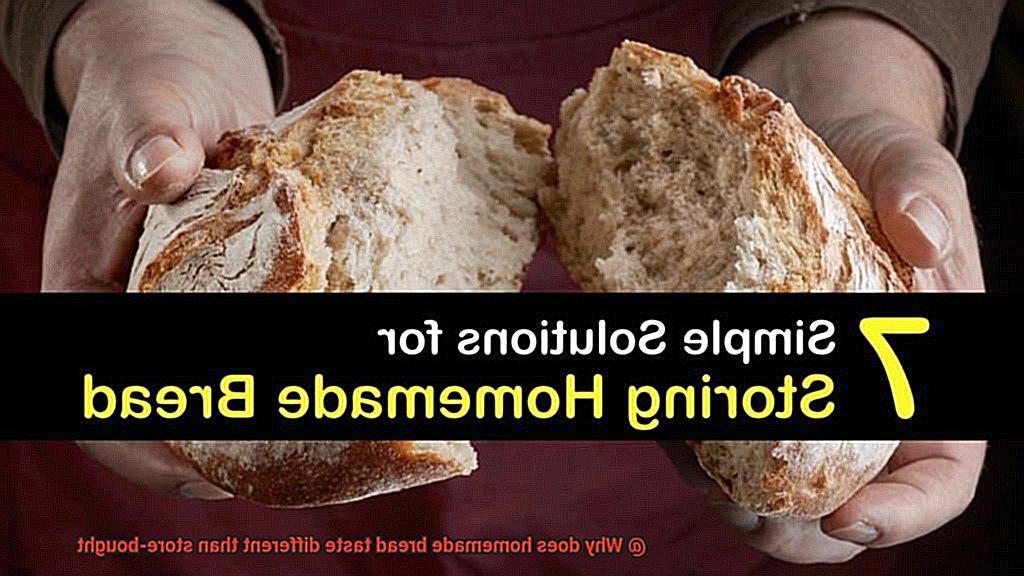
Let’s start with the positives. One of the most significant benefits of making homemade bread is freshness. Nothing beats the taste and aroma of warm, freshly baked bread straight out of the oven. Plus, since you can bake it just before you need it, it’s always at its peak freshness.
Another advantage of homemade bread is that you have complete control over the ingredients. You can customize the flavor, texture, and nutritional value to suit your preferences. Want to add some seeds or nuts for added nutrition? No problem. It’s all up to you.
Homemade bread can also be less expensive than store-bought bread if you purchase ingredients in bulk or grow them yourself. Additionally, homemade bread can be healthier than store-bought because you can control what goes into it.
However, making homemade bread also has its downsides. One significant negative is that it can be time-consuming, especially if you’re new to it. You need to set aside time for mixing, kneading, rising, and baking. However, the satisfaction of producing a fresh loaf from scratch may be worth the extra time.
To make homemade bread, you also need specialized equipment like a stand mixer or a bread machine. These items can be costly and take up space in your kitchen. Furthermore, making homemade bread requires some skill and practice. Your first few loaves may not turn out as expected, but with time and experience, you’ll undoubtedly improve.
Lastly, homemade bread lacks preservatives found in store-bought bread, which means it has a shorter shelf life and requires proper storage to prevent staleness or mold growth.
Tips for Making Delicious Home-Made Bread
There’s nothing quite like the smell and taste of freshly baked bread, especially when it’s made from scratch in your own kitchen. But how can you ensure that your home-made loaf is not only delicious but also has the perfect texture? Here are some tips to help you make the best home-made bread possible.
Choose High-Quality Ingredients
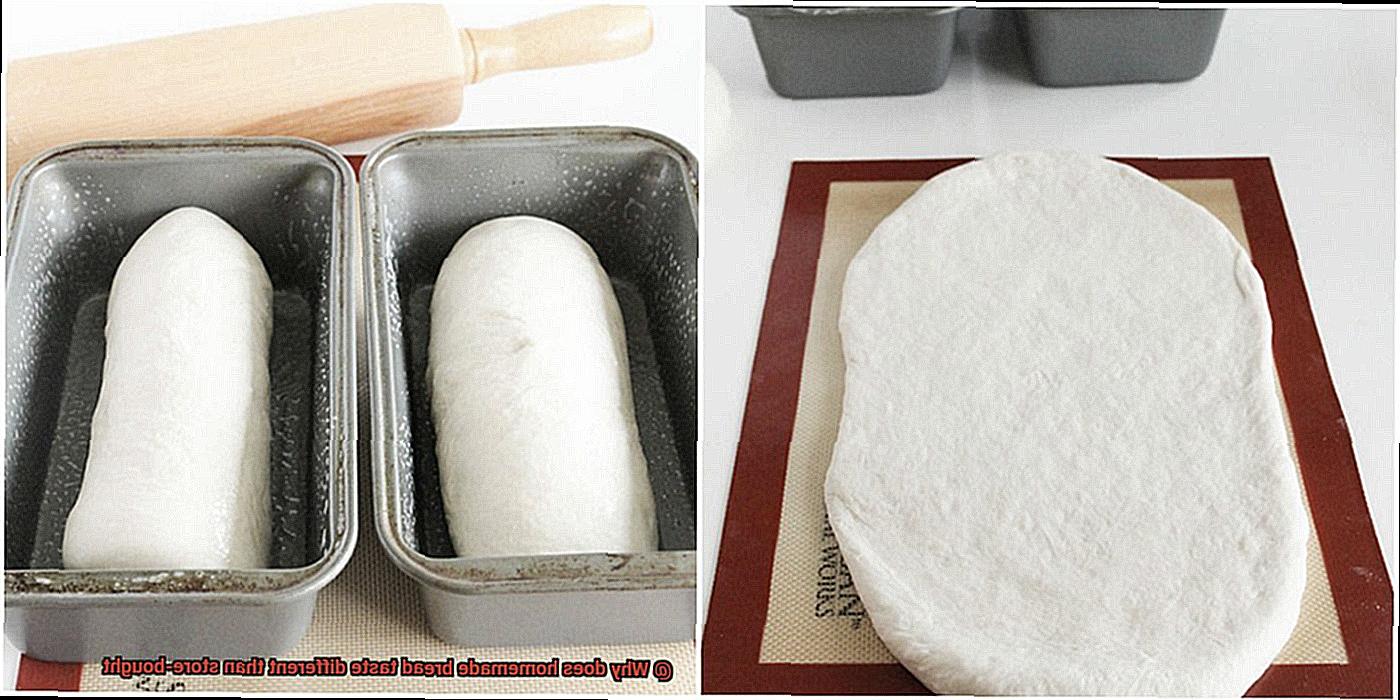
The taste of your bread will depend largely on the quality of your ingredients. Opt for unbleached flour, which has more natural flavor and nutrients than bleached flour. Use fresh yeast or sourdough starter instead of dry packet yeast, which can sometimes have a metallic taste. And don’t forget to use natural sea salt, which has a more complex flavor than table salt.
Knead the Dough Properly
Kneading the dough is essential to develop gluten, which gives bread its chewy texture. Make sure to knead the dough until it becomes smooth and elastic, which should take at least 10 minutes by hand or 5-7 minutes with a stand mixer. This will help to distribute the yeast evenly throughout the dough and ensure that it rises properly.
Let the Dough Rise Properly
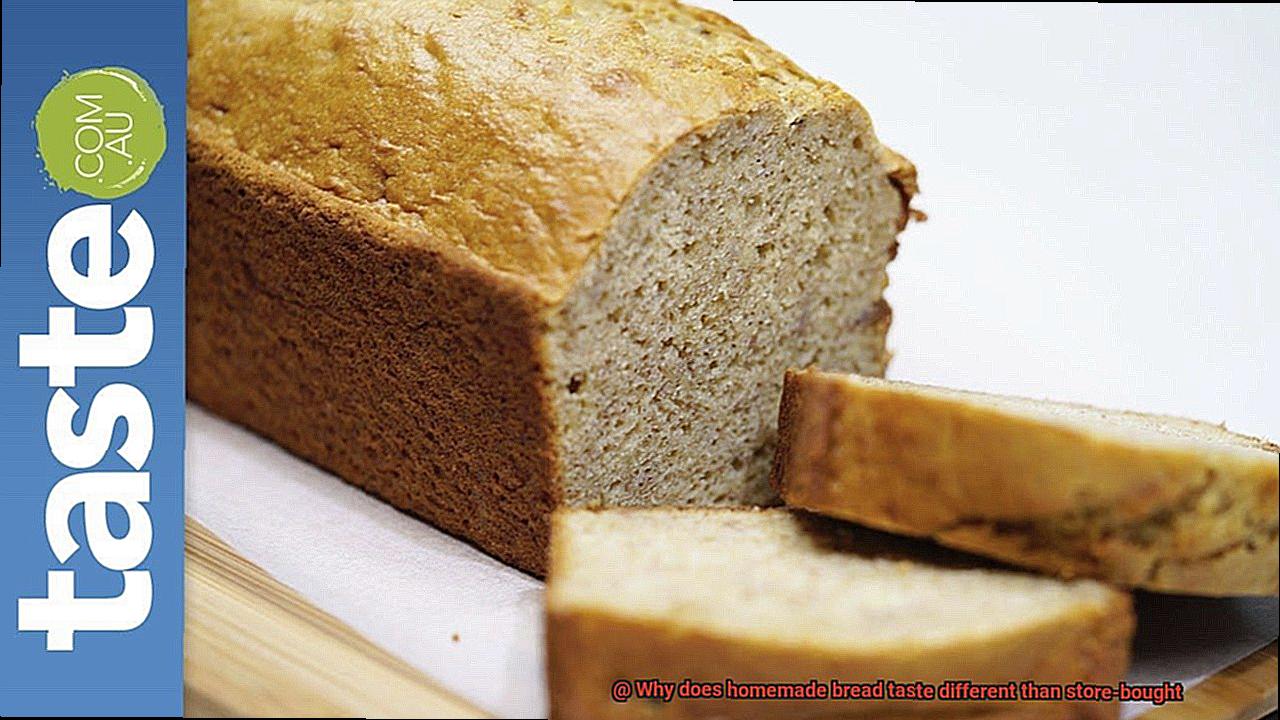
Allowing the dough to rise for the right amount of time is crucial for the flavor and texture of your bread. Follow the recipe instructions carefully, but also pay attention to the environment in which your dough is rising. A warm place (between 75-85°F) will help to create a softer, more flavorful bread.
Bake at the Right Temperature
Baking your bread at the correct temperature is important. Too low and your bread won’t rise properly, too high and it will burn. Preheat your oven to the correct temperature before baking and keep an eye on your bread while it’s in the oven.
Experiment with Different Flours and Flavorings
Don’t be afraid to get creative with your home-made bread. Try using different types of flour, such as whole wheat or rye, to add depth and complexity to your loaf. You can also add flavorings like herbs, spices, or even cheese to create unique and delicious flavor profiles.
T9zXLbdh_rE” >
Conclusion
In conclusion, the taste difference between homemade and store-bought bread is due to several factors. Homemade bread is crafted with natural ingredients and a slower fermentation process that allows for more complex flavors to develop. It’s made with love and attention to detail, which cannot be replicated in mass-produced loaves. In contrast, store-bought bread often contains artificial preservatives, flavorings, and sweeteners that can alter the taste and texture of the bread.
Apart from taste, there are also nutritional differences between homemade and store-bought bread. Homemade bread tends to be healthier as it contains fewer additives and preservatives than its store-bought counterpart. However, making homemade bread requires time and specialized equipment.
To make delicious home-made bread, it’s crucial to choose high-quality ingredients, knead the dough properly, let it rise correctly, bake at the right temperature and experiment with different flours and flavorings. With these tips in mind, you can create a mouth-watering loaf of fresh home-made bread that will leave your family and friends impressed.

